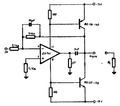Difference between revisions of "Circuit Building Blocks"
| (3 intermediate revisions by the same user not shown) | |||
| Line 24: | Line 24: | ||
===Howland Topology=== | ===Howland Topology=== | ||
* [https://circuitcellar.com/resources/quickbits/howland-current-source/ Current Source (Howland)] Voltage Controlled Current Source, see also: https://www.eevblog.com/forum/beginners/current-source-with-p-channel-mosfet-not-working-as-expected/msg5447837 | * [https://circuitcellar.com/resources/quickbits/howland-current-source/ Current Source (Howland)] Voltage Controlled Current Source, see also: https://www.eevblog.com/forum/beginners/current-source-with-p-channel-mosfet-not-working-as-expected/msg5447837 | ||
| + | |||
| + | |||
| + | [[Category:online notes]] | ||
Latest revision as of 03:46, 16 April 2024
The goal here is to have a page of various transistor circuits, but for now I'll include op amps.
They should be simple enough that you could combine them in a larger design (i.e. as part of an op amp or ASIC). I'm not going to include fundamental circuits (such as: https://en.wikipedia.org/wiki/Template:Transistor_amplifiers or basic op amps which you can find in Electronics for Inventors or AoE.)
These are sometimes called Topologies. Like a map. A map topology. If maps lie, then it's likely these circuits will lie as well. Expect any examples to be missing required components to work.
Transistor Circuits
Programmable Unijunction Transistor Sawtooth
Make Electronics: Learning by Discovery, Charles Platt
Quick Bits Examples
Most of these are also referenced in the Art of Electronics.
- Differential Pair
- Current Mirror (Wilson ver.)
- Bandgap Voltage Reference - Limiting temperature effects in semiconductors.
Unity Gain
- https://en.wikipedia.org/wiki/Diamond_buffer - Unity gain, high current.
https://www.eevblog.com/forum/projects/opamps-die-pictures/msg5450288/#msg5450288
Op Amp Circuits
Howland Topology
- Current Source (Howland) Voltage Controlled Current Source, see also: https://www.eevblog.com/forum/beginners/current-source-with-p-channel-mosfet-not-working-as-expected/msg5447837

